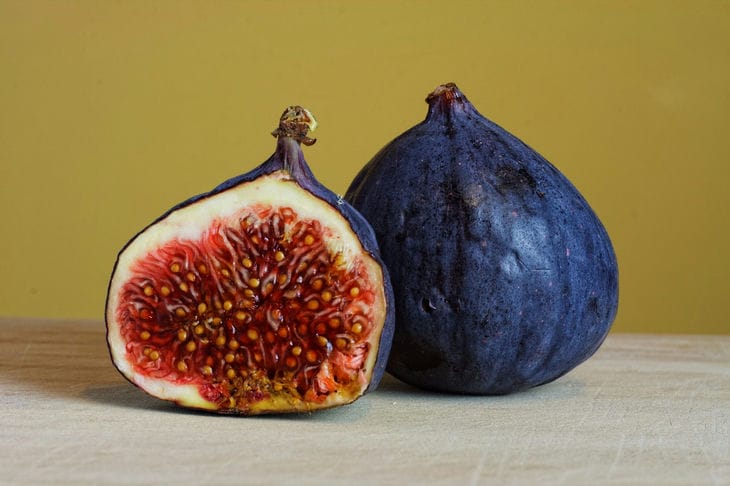Fig is a small tree with very dense, thick, strong and hard peeling bark and numerous shoots that can reach 5 to 10 meters in height.
Fig leaves are large (up to 15 centimeters long), leathery, slightly drooping, pinnately dissected, with entire edges.
The fruit is about half the size of a small apple, spherical or oval in shape, with light brown skin and a thin white coating. On the surface of the fruit, thin longitudinal or transverse stripes or lines can be seen. Inside the fruit is soft white pulp with numerous seeds.
Figs have found unusually wide application in cooking, and they are also often used in folk medicine. Their fruits contain a large number of substances useful for the human body.
Useful properties of figs
The benefits of figs are due to the presence of a large number of vitamins, macro- and microelements.

The fruits contain vitamins A, C, E, B, PP, H, folic and nicotinic organic acids and other substances beneficial to human health.
It has been established that regular consumption of fig fruits helps to strengthen health, improve the condition of skin, hair and teeth.
The benefits of figs when applied externally have been proven, as their juice is effective in treating fungal skin diseases.
Figs also help cleanse the blood, so people suffering from high blood pressure and heart disease are advised to include fresh and dried figs (at least a few) in their diet every day. The fruits are first doused with boiling water.
Figs are good for the body, but you shouldn't get too carried away with them. In large quantities, they can cause a laxative effect and bloating.
To boost your immunity, it is useful to eat several figs at once on an empty stomach. The fruit has a mild laxative effect, so it can be eaten for constipation.
Another undoubted advantage is the ability to quickly remove harmful substances from the body.
Figs are especially useful for women. They normalize the functioning of the female reproductive system, help in the fight against infertility, and this fruit is also irreplaceable during menstruation, as it reduces irritability, helps relieve headaches and improves mood.
Researchers have found that figs also have a beneficial effect on the condition of hair and skin, they can smooth out fine wrinkles, rejuvenating the skin, and they are also recommended for use in making masks.
How to choose good figs
If you want to treat yourself to fresh figs, choose fruits that are slightly unripe, but not completely green.
A ripe fruit should be firm; when lightly pressed with a finger, it springs back elastically, but then regains its shape.
Another condition is that the fruit must have a characteristic aroma. In order to check the ripeness of a fig, you need to cut it in half, if the skin easily comes off the pulp, then the fruit is ripe.
If you choose an unripe fruit, you should put it in a sunny place, and then it will ripen on its own. It is better to keep the fig in a paper bag.
When choosing dried figs, pay attention to their appearance and aroma; it should not be too weak or, on the contrary, too sweet.
Figs in cosmetology
In cosmetology, figs are used for face and body care. Masks made from fig fruits with the addition of other components make the skin elastic, promote cell regeneration, and increase its tone.
To prepare the mask, you need to mash the ripe fig pulp with a wooden spoon or pestle in a porcelain cup, add low-fat cottage cheese, sour cream or olive oil and mix thoroughly.
The mask is applied to the face for 10-15 minutes, then removed with a gauze napkin or cotton pad. The mixture can be washed off with water at room temperature.
You can make a nourishing mask for dry skin from crushed figs. To do this, crush the figs with a wooden spoon and mix with an equal amount of milk. Apply to the face and neck for 15-20 minutes. The course is 10-12 masks. The mask has a tightening effect on aging skin.
For skin care around the eyes, it is recommended to use a mask of mashed figs with the addition of 1 teaspoon of olive or peach oil. The mask is applied to the skin under the eyes for 20 minutes. After the mask, the eye area should be lubricated with cream.
Harm and contraindications
Figs are very high in calories. 100 g of dried fruit contains approximately 240-269 kcal. Therefore, overweight people should not get carried away with eating these fruits. For the same reason, figs are contraindicated for diabetes.
In addition, figs should not be combined with milk. This can lead to indigestion or cause allergies. Figs should be included in the diet of nursing mothers with caution, as they increase lactation (secretion of breast milk) and can provoke diarrhea in the baby.
Children under three years of age should only be given figs in pureed or baked form.
You should not eat raw figs if you have gastritis with increased secretion of gastric juice, gastric ulcer and duodenal ulcer.
Previously, we wrote about what foods should not be combined with cottage cheese.








